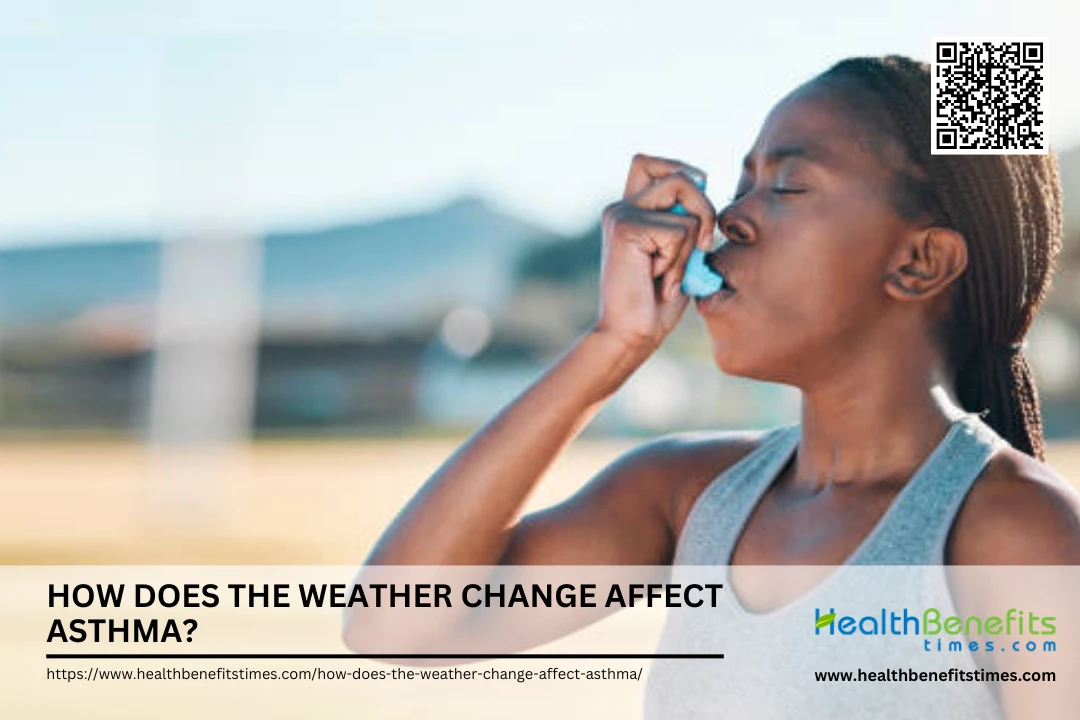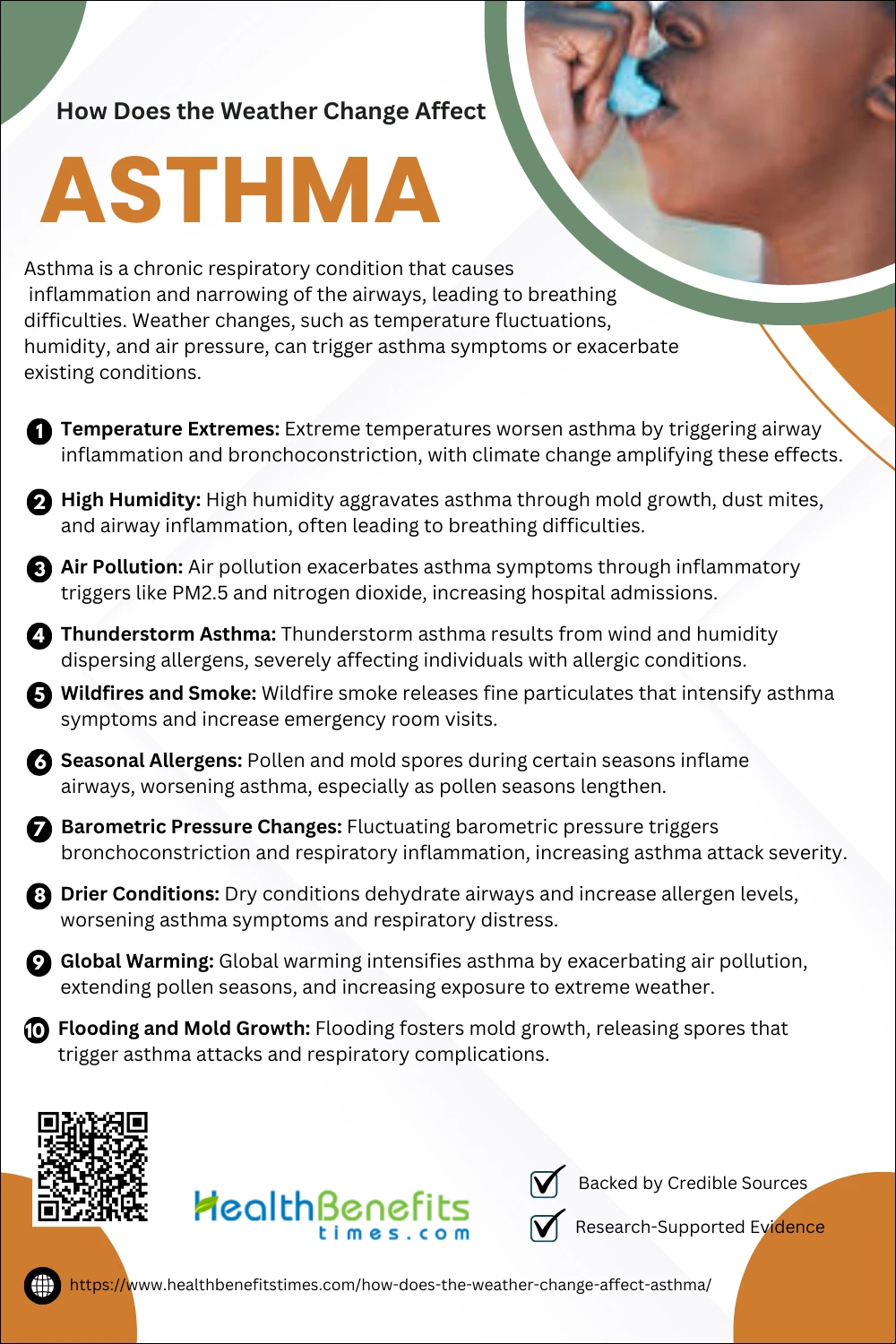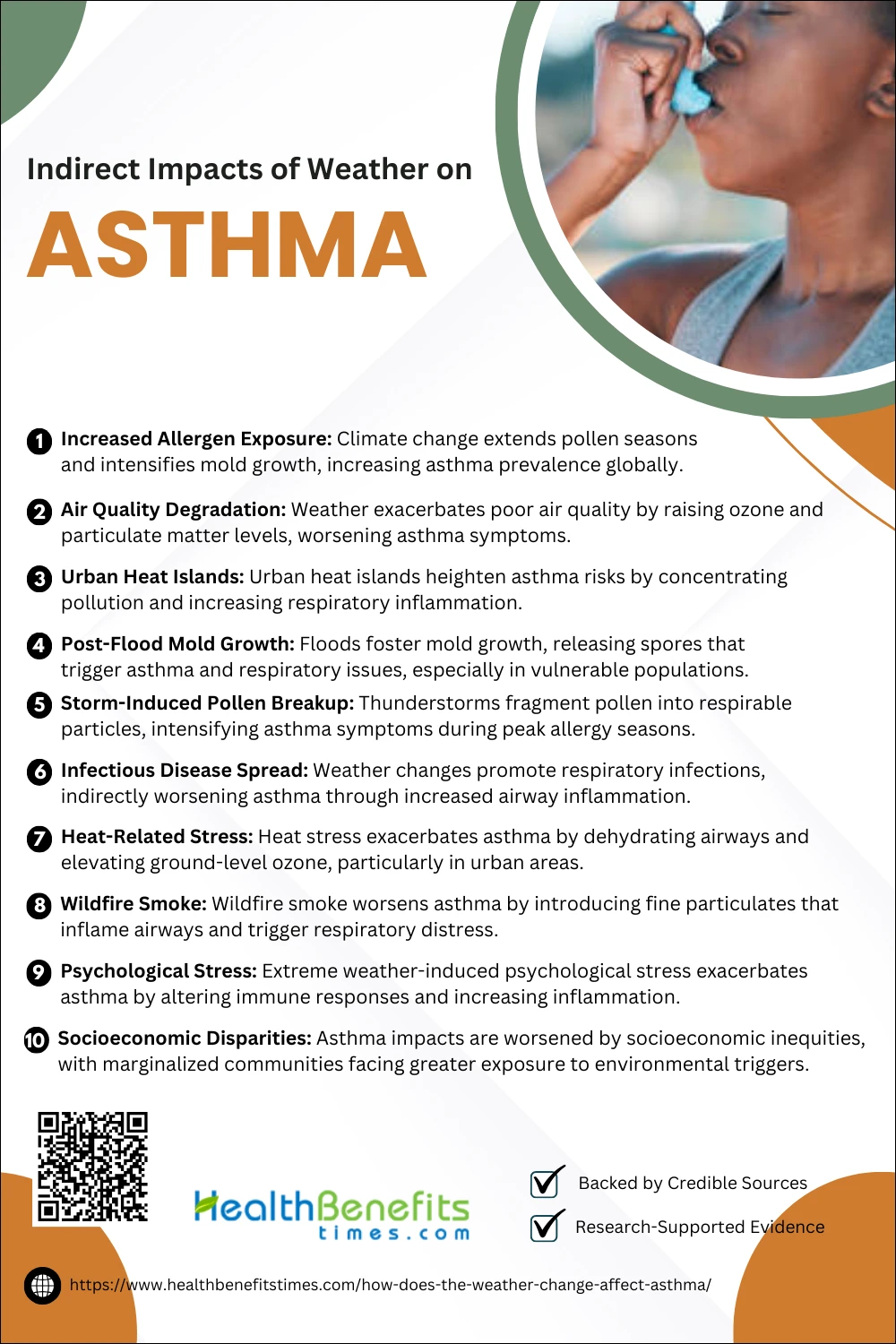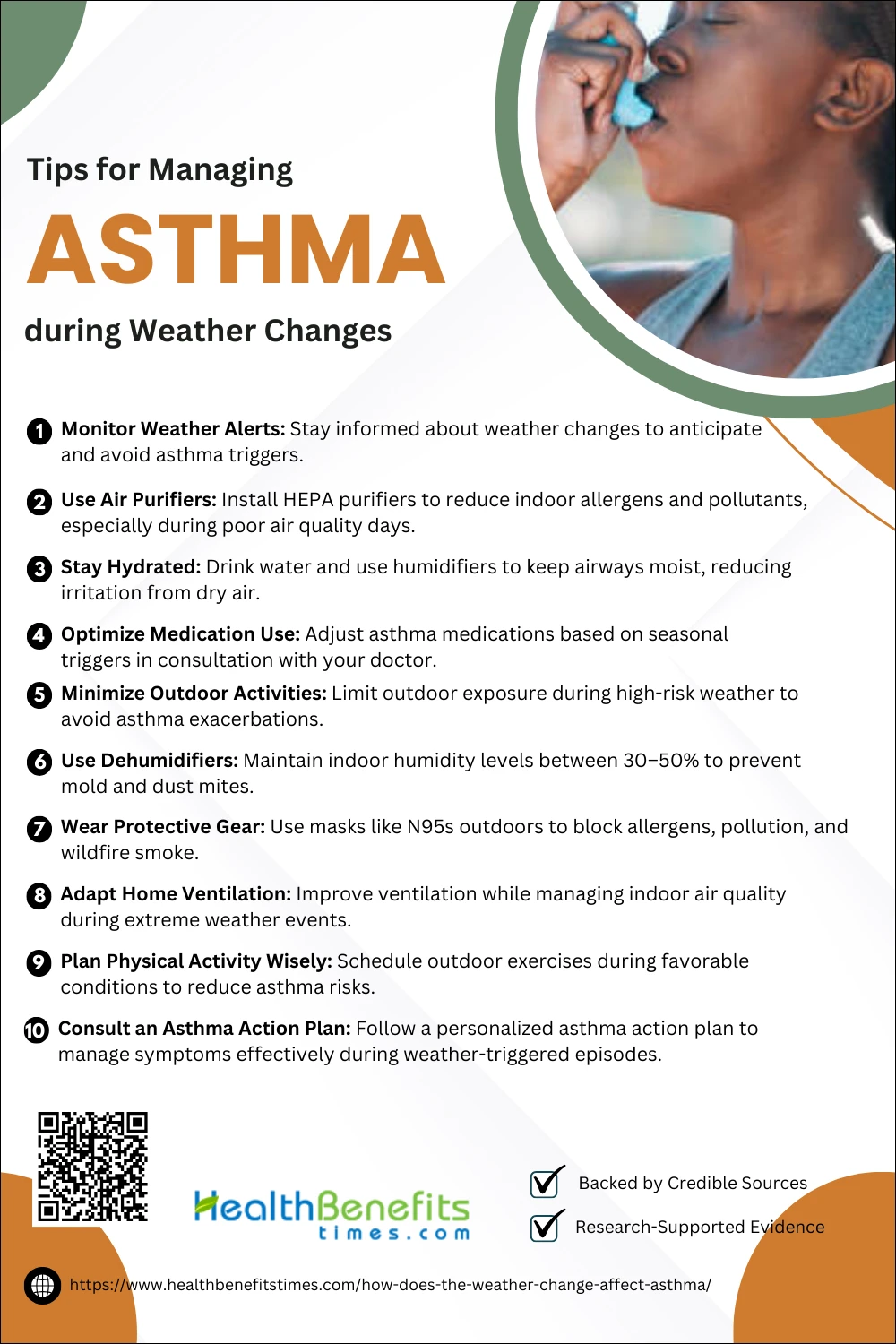- Asthma is a chronic respiratory condition that causes inflammation and narrowing of the airways, leading to breathing difficulties.
- Weather changes, such as temperature fluctuations, humidity, and air pressure, can trigger asthma symptoms or exacerbate existing conditions.
- Environmental factors like cold air, pollen, or thunderstorms can worsen airway inflammation, making asthma management more challenging.
 Asthma is a chronic respiratory condition characterized by inflammation and narrowing of the airways, leading to breathing difficulties (1). The relationship between weather changes and asthma is increasingly recognized as a significant factor in triggering asthma exacerbations. Sudden temperature shifts can cause bronchial irritation, particularly during cold weather when inhalation of dry air exacerbates respiratory symptoms (2). Humidity, often associated with thunderstorms, promotes the proliferation of allergens like mold and dust mites, which are known asthma triggers (3). High levels of air pollution during stagnant weather conditions further exacerbate symptoms, increasing hospitalization rates for asthmatic individuals (4).
Asthma is a chronic respiratory condition characterized by inflammation and narrowing of the airways, leading to breathing difficulties (1). The relationship between weather changes and asthma is increasingly recognized as a significant factor in triggering asthma exacerbations. Sudden temperature shifts can cause bronchial irritation, particularly during cold weather when inhalation of dry air exacerbates respiratory symptoms (2). Humidity, often associated with thunderstorms, promotes the proliferation of allergens like mold and dust mites, which are known asthma triggers (3). High levels of air pollution during stagnant weather conditions further exacerbate symptoms, increasing hospitalization rates for asthmatic individuals (4).
Seasonal variations, such as springtime pollen surges and winter’s respiratory infections, present unique challenges for managing asthma (5). Additionally, studies link climate change with heightened frequency of extreme weather events like heatwaves and wildfires, which significantly contribute to asthma morbidity (6). Proteomic and metabolomic analyses reveal the physiological impact of these factors on respiratory health (7). This evolving understanding underscores the need for both personal and public health strategies to mitigate the impacts of weather changes on individuals with asthma. Monitoring air quality, advancing research on climate-resilient healthcare, and implementing global air pollution controls are imperative (8).
Understanding Asthma and Environmental Triggers
Asthma is a chronic respiratory condition characterized by inflammation and narrowing of the airways, resulting in symptoms such as wheezing, shortness of breath, and coughing. The condition affects individuals of all ages and is often influenced by both genetic predisposition and environmental factors. According to recent studies, understanding the interaction between biological and external contributors can significantly aid in managing the condition effectively (9).
The causes of asthma are multifactorial, often involving a combination of genetic, immunological, and environmental influences. Genetic predisposition plays a critical role, with individuals inheriting susceptibility to allergens and airway hyperresponsiveness (10). Additionally, immune system dysfunctions and exposure to respiratory infections during early life have been identified as significant contributors to the disease’s development (11).
Environmental triggers such as air pollution, pollen, and indoor allergens exacerbate asthma symptoms by increasing airway inflammation and sensitivity. Changes in climatic conditions and urbanization have further intensified exposure to harmful pollutants, aggravating respiratory challenges (12). Preventive strategies, such as improving air quality and minimizing exposure to allergens, are essential to mitigate these effects (13). Moreover, fostering a deeper understanding of these triggers can enhance intervention strategies for those at risk (14).
How Does the Weather Change Affect Asthma?
Weather changes can significantly impact asthma, triggering symptoms like wheezing and breathlessness. Understanding these effects helps manage and prevent attacks.
 1. Temperature Extremes
1. Temperature Extremes
Temperature extremes, both hot and cold, significantly exacerbate asthma symptoms by triggering airway inflammation and bronchoconstriction. Cold air often induces bronchial spasms, while heat increases air pollution levels, worsening respiratory conditions (15). Heatwaves and cold spells disproportionately affect children and the elderly, intensifying the global burden of asthma (16). Climate change has amplified these temperature extremes, causing direct and indirect effects on asthma prevalence (17). Further research highlights the correlation between temperature spikes and hospital admissions for asthma-related emergencies (18). Preventive measures, such as adapting healthcare strategies, are essential to address this growing concern (19).
2. High Humidity
High humidity exacerbates asthma symptoms by fostering mold growth and increasing dust mite populations, common asthma triggers. Humid environments also aggravate airway inflammation, making breathing more difficult for individuals with asthma (20). Studies link high absolute humidity to increased exercise-induced bronchoconstriction in children (21). Thunderstorm asthma, associated with rapid humidity shifts, significantly raises respiratory risks (22). Humidity changes also intensify exposure to airborne allergens, aggravating asthma globally (23). Effective humidity control is crucial for mitigating asthma impacts (24).
3. Air Pollution
Air pollution significantly exacerbates asthma by triggering inflammation and increasing airway hyperresponsiveness. Fine particulate matter (PM2.5) and nitrogen dioxide are known to worsen asthma symptoms and lead to increased hospital admissions (25). Studies show that polluted urban areas often report higher asthma prevalence due to vehicular emissions (26). Indoor air pollutants like mold and dust further contribute to chronic asthma issues (27). E-health strategies in remote regions are exploring solutions to mitigate these effects (28). Community awareness programs are essential for prevention (29).
4. Thunderstorm Asthma
Thunderstorm asthma occurs when environmental conditions, like high pollen and moisture levels, combine with storm-induced wind patterns to disperse fine allergenic particles into the air, triggering severe asthma attacks (30). These events disproportionately affect individuals with allergic rhinitis or poorly controlled asthma (31). Climate change amplifies these episodes by extending pollen seasons and intensifying storms (22). Effective early-warning systems and public awareness are critical for prevention (29).
5. Wildfires and Smoke
Wildfires release fine particulate matter (PM2.5) that penetrates deep into the lungs, triggering asthma attacks and exacerbating respiratory conditions (32). Exposure to wildfire smoke significantly increases emergency room visits for asthma patients, particularly during intense fire seasons (33). Studies also reveal a stronger correlation between wildfire smoke PM2.5 and respiratory issues compared to non-smoke PM2.5 (34). Mitigation efforts, such as air filtration and public warnings, are crucial for reducing these health impacts (35).
6. Seasonal Allergens
Seasonal allergens, such as pollen and mold spores, significantly exacerbate asthma by increasing airway inflammation and sensitivity. Pollen from grasses and trees during specific seasons is a leading trigger for asthma attacks in predisposed individuals (36). Climate variability has lengthened pollen seasons, aggravating asthma globally (37). Inhalation of fungal spores during humid seasons worsens asthma symptoms (38). Effective management requires allergen avoidance and pharmacotherapy (39). Rising allergen sensitization rates underscore the urgent need for comprehensive care strategies (40).
7. Barometric Pressure Changes
Barometric pressure fluctuations, often linked to weather changes, significantly exacerbate asthma symptoms by altering airway dynamics and triggering bronchoconstriction. Low pressure before storms can increase the severity of asthma attacks (41). Studies reveal that these changes intensify respiratory inflammation, particularly when coupled with poor air quality (42). Barometric shifts also worsen airway hyperinflation in chronic asthmatics (43). Preventive care and early warning systems are crucial for managing such events (44). Monitoring weather patterns is essential to reduce asthma-related hospitalizations (45).
8. Drier Conditions
Drier conditions significantly exacerbate asthma by increasing airway dehydration, which triggers bronchoconstriction and respiratory distress (46). Prolonged dry weather elevates airborne allergen concentrations, such as pollen and dust, further intensifying asthma symptoms (47). Dehydrated airways increase the susceptibility to irritants, worsening respiratory inflammation (48). Additionally, extreme dryness disrupts lung hydration levels, compromising pulmonary defenses.
9. Global Warming
Global warming exacerbates asthma by intensifying air pollution, extending pollen seasons, and increasing exposure to allergens and extreme weather events. Rising temperatures heighten ground-level ozone levels, worsening respiratory inflammation (49). Studies also reveal increased asthma attacks during heatwaves linked to global warming (50). Seasonal climate shifts amplify the health burden of respiratory conditions (51). Comprehensive climate-responsive health strategies are critical to mitigate these risks (52).
10. Flooding and Mold Growth
Flooding creates ideal conditions for mold growth, which releases airborne spores that exacerbate asthma symptoms. These molds significantly increase respiratory distress in affected populations (53). Studies highlight that individuals exposed to post-flood environments have higher hospital admission rates due to mold-triggered asthma attacks (54). Chronic exposure can also sensitize asthmatics to new allergens, further worsening the condition (55). Strategies for mitigation, including improved post-flood ventilation, significantly reduce mold-related asthma complications (56). Addressing housing conditions remains critical to protecting respiratory health (57).
Indirect Impacts of Weather on Asthma
Weather indirectly affects asthma by influencing indoor air quality, promoting mold growth, increasing allergens, and altering behaviors like outdoor activity levels.
 1. Increased Allergen Exposure
1. Increased Allergen Exposure
Climate change indirectly increases allergen exposure by extending pollen seasons and intensifying mold growth due to prolonged humidity and higher temperatures (17). Urbanization exacerbates these effects by increasing allergenic pollutants in the air (51). Rising global temperatures also enhance indoor allergen production, such as volatile organic compounds. These changes lead to higher asthma prevalence and severity worldwide (58). Adaptation measures are critical to mitigate these risks (59).
2. Air Quality Degradation
Weather patterns exacerbate air quality degradation by increasing ground-level ozone and fine particulate matter (PM2.5), which worsen asthma symptoms (17). Prolonged heatwaves intensify pollutant levels, leading to respiratory inflammation (60). Climate change-driven droughts contribute to airborne dust and allergens, aggravating asthma (61). Urbanization amplifies pollutant concentrations in densely populated regions (62).
3. Urban Heat Islands
Urban heat islands (UHIs) amplify asthma risks by raising temperatures and concentrating air pollution in urban areas, leading to increased respiratory inflammation (60). Elevated ground-level ozone during UHIs worsens asthma symptoms (17). UHIs also enhance particulate matter retention, aggravating airway sensitivity (62). Adaptive urban planning can mitigate UHI impacts (63).
4. Post-Flood Mold Growth
Post-flood environments foster mold growth, releasing airborne spores that exacerbate asthma symptoms and respiratory diseases (64). Mold exposure in damp, water-damaged buildings significantly increases asthma-related hospital visits (65). Vulnerable populations, including children and the elderly, are disproportionately affected (66). Effective mold remediation reduces health risks (67). Public health initiatives can mitigate long-term impacts on respiratory health (68).
5. Storm-Induced Pollen Breakup
Storm-induced pollen breakup disperses allergenic particles into the air, exacerbating asthma symptoms by triggering airway inflammation. Thunderstorms swell pollen grains, fragmenting them into respirable particles (69). These microscopic particles penetrate deeper into the lungs, intensifying respiratory distress (70). Studies confirm the phenomenon disproportionately affects urban populations during peak allergy seasons (71). Increasing global warming worsens these events (72). Public awareness is critical for mitigating impacts (73).
6. Infectious Disease Spread
Weather changes facilitate the spread of infectious respiratory diseases, exacerbating asthma symptoms through increased inflammation (74). Rising global temperatures contribute to enhanced viral activity, indirectly affecting asthma management (62). Regions with poor air quality see intensified effects (75). Adaptation strategies are critical to mitigate these impacts (65).
7. Heat-Related Stress
Heat-related stress exacerbates asthma by triggering airway inflammation and increasing sensitivity to allergens. Rising temperatures elevate ground-level ozone, worsening respiratory conditions (62). Prolonged heat exposure dehydrates airways, intensifying bronchoconstriction (65). Urban heat islands amplify these effects, especially in densely populated regions (74). Effective urban planning and hydration strategies are critical (75).
8. Wildfire Smoke
Wildfire smoke significantly exacerbates asthma by introducing fine particulate matter (PM2.5) that inflames airways and triggers respiratory distress (76). Long-term exposure to smoke increases asthma-related emergency visits (77). The combination of toxic substances in wildfire smoke worsens pre-existing asthma conditions (78). Urban areas suffer amplified effects due to pollution accumulation (79). Mitigation strategies are essential to combat these risks (80).
9. Psychological Stress
Psychological stress triggered by extreme weather events exacerbates asthma by increasing airway inflammation and altering immune responses (81). Prolonged exposure to adverse weather can cause mental health issues that complicate asthma management (82). Community-level resilience-building initiatives are critical for addressing these indirect effects (83).
10. Socioeconomic Disparities
Socioeconomic disparities amplify asthma’s indirect impacts by limiting access to healthcare and exposing vulnerable populations to poor air quality (84). Urban areas with concentrated poverty experience heightened asthma rates due to environmental injustices (85). Disparities in housing quality also exacerbate indoor allergen exposure (86). Climate change further intensifies these inequities, disproportionately affecting marginalized communities (87). Policy interventions can address these structural issues (88).
Tips for Managing Asthma during Weather Changes
Managing asthma during weather changes involves monitoring forecasts, using prescribed medications, improving indoor air quality, and following an asthma action plan.
 1. Monitor Weather Alerts
1. Monitor Weather Alerts
Stay informed about weather forecasts, especially during allergy seasons or extreme weather events. Tools like weather apps or asthma alert systems can help you prepare in advance. For example, pollen forecasts can guide outdoor activity planning to minimize exposure during peak periods.
2. Use Air Purifiers
Install high-efficiency particulate air (HEPA) purifiers in your home to reduce allergens, dust, and pollution indoors. Air purifiers are particularly helpful during wildfire seasons or high smog days, keeping indoor air safe for individuals with asthma.
3. Stay Hydrated
Hydration helps maintain moist airways, reducing irritation caused by dry air during heatwaves or cold spells. Drinking water throughout the day and using a humidifier in drier climates can prevent asthma exacerbations.
4. Optimize Medication Use
Consult with your doctor to adjust your asthma medication plan based on seasonal triggers. For example, increasing the use of preventive inhalers during high pollen seasons can help manage symptoms effectively.
5. Minimize Outdoor Activities
Limit outdoor exposure during high-risk weather, such as windy days during pollen season or hot, humid days with high pollution. Plan outdoor activities during early mornings or evenings when conditions may be more favorable.
6. Use Dehumidifiers
High indoor humidity fosters mold growth, a common asthma trigger. A dehumidifier keeps humidity levels between 30–50%, reducing the risk of mold and dust mites.
7. Wear Protective Gear
Wear a high-quality mask, such as an N95, during outdoor activities in high pollen, pollution, or wildfire smoke conditions. Masks block small particles and allergens, helping prevent asthma triggers.
8. Adapt Home Ventilation
Proper ventilation reduces indoor pollutants. Open windows on days with good air quality and use exhaust fans in kitchens and bathrooms. During wildfire or smog events, seal windows and use air purifiers.
9. Plan Physical Activity Wisely
Exercise-induced asthma can worsen during extreme weather. Perform outdoor exercises in moderate conditions and avoid high pollen or heatwave days. Warm-up exercises can reduce the likelihood of attacks.
10. Consult an Asthma Action Plan
Collaborate with your healthcare provider to develop an asthma action plan. This includes step-by-step instructions for managing symptoms during weather-triggered episodes and knowing when to seek medical help.
When to Seek Medical Attention
Medical attention is crucial if asthma symptoms worsen despite medication, or if you experience persistent breathlessness, chest tightness, or frequent nighttime symptoms (89). Immediate care is necessary for severe attacks requiring multiple rescue inhaler doses (90). Symptoms such as bluish lips or difficulty speaking indicate emergencies (91). Timely intervention reduces risks of complications (92). An updated asthma action plan supports early care decisions (62).
Conclusion
Weather changes can significantly impact asthma, triggering symptoms through direct and indirect environmental factors like temperature shifts, humidity, and allergens. By understanding these effects and implementing proactive strategies—such as monitoring weather conditions, maintaining indoor air quality, and following a personalized asthma action plan—individuals can better manage their symptoms and reduce the risk of severe attacks. Staying informed and consulting healthcare professionals when needed ensures a healthier, more comfortable life for those living with asthma, regardless of changing weather patterns.
References:
- National Heart, Lung, and Blood Institute. (n.d.). Asthma.
- Frontiers in Climate. (2024). Impact of Climate Change on Respiratory Health.
- (2025). Climatic Factors and Asthma.
- Environmental Health Perspectives. (2024). Pollution and Asthma Exacerbations.
- Journal of Allergy and Clinical Immunology. (2025). Seasonal Asthma Trends.
- Heritage Foundation. (2024). Ozone, Climate Change, and Health.
- (2025). Metabolomics in Asthma Research.
- Oxford Academic. (2024). Public Health and Climate Resilience.
- CL Padasak, S Boring, A Engleson. (2024). Deaths from asthma: a series of cases and their presentations. American Journal of Clinical Pathology.
- HJ Pybus, P Dangarh, MYM Ng, CM Lloyd. (2025). Mechanistic modelling of allergen-induced airways disease. Scientific Reports.
- K Chan, R Hoffman. (2024). Zhen Wu Tang: A case report unveiling the lung-gut axis in asthma. Convergent Points.
- T Hisada, Y Nishimura, K Dobashi. (2025). Allergy and immunotoxicology in bronchial asthma. PubMed.
- G Carrillo, N Mendez-Dominguez. (2024). The housing environment and its effect on asthma. Springer Environmental Science.
- I Ojanguren, S Quirce, I Bobolea. (2025). Advances in understanding and managing asthma. PubMed.
- Alcala, E., Chan, S., Chalotra, G., Ramirez, A. (2024). Empowering Communities for a Sustainable Future. Fresno State University.
- Abir, M., Vardavas, R., Tariq, Z.H., Hoch, E. (2024). Impact of Climate Change on Health and Drug Demand. RAND Corporation.
- Le Souëf, P.N., Adachi, Y., Anastasiou, E. (2024). Global change and asthma in children. World Allergy Organization.
- Frueh, L., Sharma, R., Sheffield, P.E. (2024). Community Violence and Asthma. Annals of Allergy, Asthma & Immunology.
- Razavi-Termeh, S.V., Sadeghi-Niaraki, A., Ali, F. (2024). Spatio-temporal modeling of asthma-prone areas. Sustainable Cities and Society.
- Shaikh, A. A., Boniface, M. A., Naeem, N., Husain, S. A. (2024). Evaluating the Role of Maximal Expiratory Flow at 25% in Managing Small Airway Disease. PMC NIH.
- Tikkakoski, P. (2024). The Association of Physical and Biological Factors with Exercise-Induced Bronchoconstriction. Tampere University.
- Beggs, P. J. (2024). Thunderstorm Asthma and Climate Change. JAMA.
- Derrick, D., Gick, B., Jermy, M. (2024). Human Aeroecology and Its Impact on Asthma. Frontiers in Ecology and Evolution.
- Tikkakoski, P., Reini, M., Sipilä, K., Kivistö, J. E. (2024). Association of Humidity with Asthma Incidence in Children. Wiley Online Library.
- Emmanuel, O. K., Aria, J., Jose, D., Diego, C. (2024). Toxicological Effects of Air Pollution on Respiratory Diseases. ResearchGate.
- Wang, M., Zhang, Y., Li, J., Wang, C., Zhang, L. (2025). Air Pollution and Its Influence on Respiratory Conditions. JAMA.
- Baruah, N., Buragohain, P. (2024). Airborne Fungal Flora in Relation to Human Health. Explore Bioscene.
- Salmi, E. M., Basile, F. W., Khan, F. A. (2025). E-Health for Chronic Respiratory Diseases in Remote Areas. Springer.
- Hashem, R. B., Siddique, A. B., Rasel, S. M., Hossain, M. S. (2024). Public Awareness on Air Pollution and Health. BMC Public Health.
- Cabanillas, B. (2024). Molecular and Cellular Advances in Atopic Diseases. MDPI.
- D’Amato, G. D., & D’Amato, M. (2024). Allergens as Trigger Factors for Respiratory Diseases During Thunderstorms. Academia.
- Bowman, W. S., Schmidt, R. J., Sanghar, G. K. (2024). Air That Once Was Breath: Wildfire Smoke-Induced Mechanisms of Airway Inflammation. Karger.
- Henderson, S. B. (2024). The Public Health Paradox of Wildfire Smoke. BCMJ.
- Wang, W., Li, L., Zhu, Q., D’Souza, R. R. (2024). Associations Between Wildfire Smoke PM2.5 and Respiratory ED Visits. EHP.
- Wallace, D. R., Buha Đorđević, A. (2024). Linking Environmental Exposure to Toxicants and Chronic Disease. Frontiers in Toxicology.
- Symon, F., Anees‐Hill, S., Satchwell, J., Fairs, A. (2024). A fungal spore calendar for England. Figshare.
- Daungsupawong, H. (2024). Impact of Seasonal Allergens on Respiratory Health. World Allergy Organization Journal.
- González-Pérez, R., Galván-Calle, C. A., Galán, T. (2024). Molecular Signatures of Aeroallergen Sensitization. MDPI.
- Kohli, K. K. (2024). Efficacy and Safety of Antihistamines in Allergic Rhinitis. Medical Dialogues.
- Choi, Y. J., Lee, K. S., Oh, J. W. (2024). Trends in Allergen Sensitization. PMC.
- Santos, M. P., Campinas, A., Coelho, R. (2024). Hamman’s Sign: Rediscovering Cardiac Auscultation Through Pneumomediastinum. Acta Médica Portuguesa.
- Barrera-Heredia, A. D., Zafra-Mejía, C. A. (2024). Atmospheric Pressure and Asthma: A Correlation. MDPI.
- Fernandes, A., Avraam, D., Cadman, T., Dadvand, P. (2024). Barometric Influence on Chronic Asthma. ScienceDirect.
- Cruces, P. (2024). Status Asthmaticus: Mechanisms and Treatments. PCCM.
- Ramirez, J. C., Wang, J., Hu, W. (2024). Meteorological Parameters and Asthma Outcomes. Springer.
- Lee, C. C., Sheridan, S. C., Lin, S. (2012). Relating Weather Types to Asthma-Related Hospital Admissions. EcoHealth.
- Demain, J. G. (2018). Climate Change and Its Impact on Respiratory Diseases. Springer.
- Moloney, E., O’Sullivan, S., Hogan, T., Poulter, L. W. (2002). Airway Dehydration: A Therapeutic Target in Asthma. Chest Journal.
- Kaur, A., Shabanova, V., Godse, S., Flom, J. (2024). Parental Perspectives: Pediatric Asthma and Climate Change. ATS Journals.
- Rosario, C. S., Urrutia-Pereira, M., Murrieta-Aguttes, M. (2024). Air Pollution and Rhinitis. Frontiers in Allergy.
- Turkalj, M., Banić, I. (2024). Risk Factors for Allergic Diseases. Liječnički vjesnik.
- Antico, A., Bocchi, C., Ariano, R. (2024). Allergy in the Po Valley and Climate Change. Exploration Pub.
- Milk, G., Buster, T. T. A. (2024). Allergy Season: It’s Bad and Getting Worse. Bona Sana Health.
- Centers for Disease Control and Prevention. (2024). Mold and Health Risks After Flooding. CDC.
- National Institutes of Health. (2024). Flooding and Mold: Health Risks. NIH.
- World Health Organization. (2024). Addressing Housing and Asthma. WHO.
- (2024). Asthma and Flood Exposure. PubMed.
- Hosseini, Z., Gholami, M. (2024). Impact of climate on health. PubMed.
- Brannan, J. D., Lindley, M. R. (2024). Asthma and allergen adaptation. Wiley.
- Dutta, A., Singh, H., Qamar, M. Q., Kottuppalli, T. M. (2024). Urban pollution and its health impacts. Springer.
- Sharma, M., Jain, R., Kumar, P. (2024). Airborne pollutants and respiratory health. ResearchGate.
- Hosseini, Z., Gholami, M. (2024). Climate-driven air pollution effects. PubMed.
- Lindgren, J. (2024). Adaptive strategies for UHI mitigation. ResearchGate.
- Bolton, A. (2018). Climate change and environmental health. ESR.
- Parker, E. R., Goodman, R. S. (2022). Extreme weather impacts. ScienceDirect.
- Minamiguchi, N. (2020). Health risks post-flood. ResearchGate.
- Merdjanoff, A. A., Piltch-Loeb, R. (2021). Vulnerabilities in flood disasters. Springer.
- Erickson, T. B., Brooks, J. (2019). Environmental health effects post-flood. TandF.
- NSW Health. (2024). Thunderstorm Asthma: How Weather Affects Breathing. NSW Health.
- com. (2024). Seasonal Allergies and Asthma: Impacts of Pollen. Asthma.com.
- (2024). Urban Air Quality and Asthma in Thunderstorm Events. PubMed.
- Mayo Clinic. (2024). Understanding Asthma Triggers in Stormy Weather. Mayo Clinic.
- (2024). Managing Asthma During Extreme Weather. NIH.
- Yeo, A., Lui, J. K. (2024). Respiratory health and climate-induced infectious diseases. Allen Press.
- (2024). Climate change and respiratory health risks. NIH.
- Heft-Neal, S., Gould, C. F., Childs, M. (2023). Health effects of wildfire smoke. NBER.
- Liu, J. C., Pereira, G., Bravo, M. A. (2015). Physical health impacts from wildfire smoke. ScienceDirect.
- Grigorieva, E., Lukyanets, A. (2021). Wildfire smoke and respiratory health. MDPI.
- Gould, C. F., Heft-Neal, S. (2024). Urban impacts of wildfire smoke. Annual Reviews.
- Reid, C. E., Brauer, M. (2016). Wildfire smoke exposure and asthma. EHP.
- Uyanaeva, A. I., Pogonchenkova, I. V. (2024). Psychological stress and asthma severity in extreme weather. PubMed.
- Rodriguez, M. G., Patel, N. (2024). Building resilience in weather-induced stress. Springer.
- Walker, P. H., Zheng, Y. (2024). Social stressors and asthma outcomes. ScienceDirect.
- Martinez, A., de la Rosa, R., Mujahid, M. (2021). Structural Racism and Asthma. ScienceDirect.
- Alsallakh, M. A., Rodgers, S. E., Lyons, R. A. (2021). Socioeconomic Deprivation and Asthma Care. PLoS Medicine.
- Akinyemi, O., Weldeslase, T., Odusanya, E. (2024). Economic Disparities in Asthma Care. Frontiers.
- Smiley, K. T. (2019). Environmental Inequalities and Asthma. JSTOR.
- Williams, D. R., Sternthal, M., Wright, R. J. (2009). Social Determinants of Asthma. NIH.
- Leszczynski, D. (2024). Wireless Radiation and Health. Frontiers in Public Health.
- Maughan, B. C., Kabrhel, C., Jarman, A. F. (2025). Evidence-Based Asthma Management. JAMA Network Open.
- Chuleerarux, N., Makkoukdji, N., Satnarine, T. (2025). Asthma and Emergency Interventions. MDPI Medicina.
- Tsoulis, M. W., Williams, K. W. (2024). Advances in Asthma Treatment. Annals of Allergy, Asthma & Immunology.

